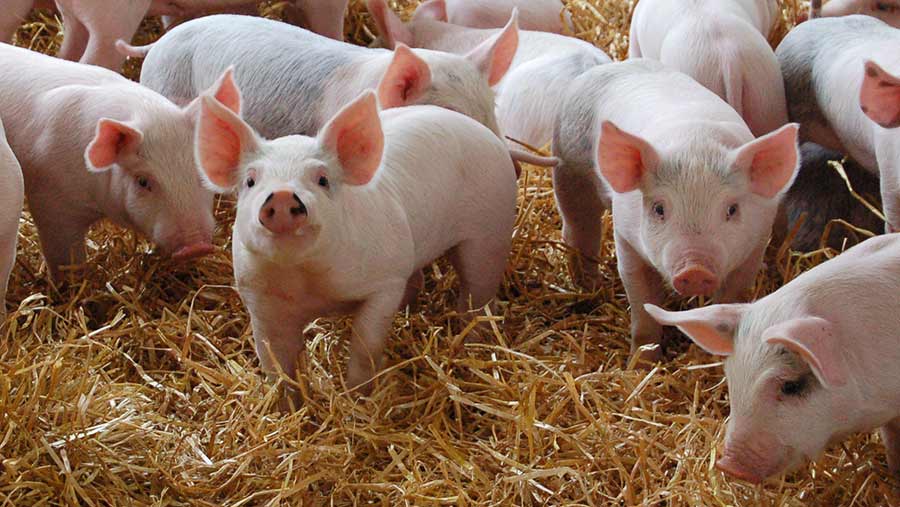Advice for controlling PRRS in pigs

Porcine reproductive and respiratory syndrome (PRRS) is a viral infection that is estimated to cost producers in the region of £70 a sow a year and £3.50 a finisher.
Many different factors can affect disease development, severity and circulation, so having a methodical approach to prevention and control is key, says Andrew Palmer, knowledge exchange manager at AHDB Pork.
“Although present year-round, PRRS tends to flare up during autumn and winter. This is most likely down to the environmental conditions – cool and damp – not only favouring its survival, but making effective cleaning and disinfecting more difficult,” Mr Palmer added.
See also: Gene editing used to create PRRS-resistant pigs cells
What is PPRS?
- An extremely costly, viral pig disease
- First clinical signs observed in the UK in May 1991
- Also referred to as blue ear
- Can affect severely both breeding and growing animals
- Infection can result in reproductive losses (return to oestrus and abortions), high pre-weaning mortality, reduced growth and increased susceptibility to other diseases
- It can be introduced to a herd via replacement pigs and vectors, such as flies, and is windborne over short distances
- Once within a herd, the virus is transmitted via nose-to-nose contact, contaminated needles, muck or semen, sow to piglet during pregnancy and other vectors [MD2]
The fluctuations in temperatures and difficulties getting ventilation systems working effectively can also predispose pigs to outbreaks of respiratory and other diseases.
When deciding on interventions, it’s important not to focus on just one point but to have a holistic approach.
Most of the time, vaccination is part of the control programme, but it needs to be implemented with other, equally important measures, such as biosecurity, management practices and gilt acclimatisation.
Below, Mr Palmer provides his seven tips on keeping PRRS out of the herd and minimising its spread:
- If it’s an option, closing the herd is the most effective method of keeping out PRRS. But if that’s not possible, there are still other steps you can take (see below).
- Carry out a biosecurity audit with your vet and identify high-risk areas. It is also a good opportunity to get on top of cleaning and disinfecting practices.
- Evaluate areas where disease could be transmitted. Look at pig movements and flow, management practices, location and farm visitors.
- Only use replacements that have been bred on farm. If it is necessary to bring gilts in, only introduce them to the herd after a quarantine period (between two and eight weeks). Farmers should also allow time for appropriate vaccinations to be given and a period to allow shedding – see AHDB Pork factsheet, Action for Productivity 35 (Gilt Management), for additional guidelines.
- If your system will allow it, operate a strict all-in-all-out policy.
- Avoid cross-fostering after 48 hours and only then when absolutely necessary to reduce disease transmission to piglets and prevent contact between different age groups.
- If in a pig-dense region, consider a regional eradication program [MD1] (see “Eradicating PRRS from East Anglia”).
Eradicating PRRS from East Anglia
Regional control programmes, such as one already under way in East Anglia, rely on vaccination to lower the virus spread.
First, diagnostics are carried out to assess the herd status. The programme, which has been running for two years, includes whole-herd vaccination.
This sees breeding animals vaccinated on positive farms. Mass vaccination would typically be carried out with Porcilis PRRS every four months or at regular intervals, giving one dose at mid-gestation and another in lactation. Piglets are also vaccinated with Porcilis PRRS at 14 days old, continuously.
Recommendations are also made on hygiene, pig flow and biosecurity.
A one-size-fits-all approach won’t work though, and a discussion needs to be had between vet and farmer at an individual level to assess the best options for particular circumstances.
Best practice during vaccination is extremely important, according to Ricardo Neto, UK technical manager for pigs at MSD Animal Health.
“Control programmes using vaccines need to be tailor-made for each farm’s conditions and goals. In some situations, whole-herd vaccination may be needed to reach herd stabilisation more quickly.”
During vaccination, specifically during piglet vaccination, the use of needle-free devices can help to minimise the possible horizontal transmission of PRRS from pig to pig, says Mr Neto.
Another advance on PRRS control and eradication is the range of new technologies that can help you evaluate the biosecurity robustness of your farm and, ultimately, calculate return on investment of the vaccines used to protect your herd.
AHDB Pork, for example, has an app that demonstrates good practice and common mistakes on pig farms.
PRRS control is a team effort and all stakeholders need to play an active part. It also paramount for staff to understand the importance of complying with vaccination practices, correct storage and handling of vaccines. Only by doing so will the chances of controlling this disease be maximised.
If you want to get on board with the East Anglian regional control programme, for which the next round of mass vaccinations is about to get under way, get in touch with either your vet or Andrew Palmer at AHDB Pork (andrew.palmer@ahdb.org.uk).
For more information on PRRS, see AHDB Pork factsheet, Action for Productivity 41.
Pig diseases A-Z
Check out the Pig Health tool from Pig Progress. It can help you identify, prevent and treat a huge range of pig diseases and health issues. Find a disease now.
